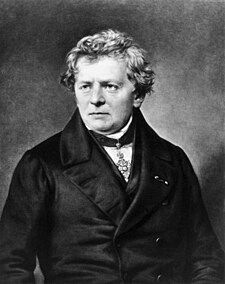Georg Ohm
| Georg Simon Ohm | |
|---|---|
 |
|
| Born |
16 March 1789 Erlangen, Brandenburg-Bayreuth (present-day Germany) |
| Died | 6 July 1854 (aged 65) Munich, Kingdom of Bavaria |
| Residence | Brandenburg-Bayreuth, Bavaria |
| Nationality | German |
| Fields | physics (electricity) |
| Institutions | University of Munich |
| Alma mater | University of Erlangen |
| Doctoral advisor | Karl Christian von Langsdorf |
| Known for |
Ohm's law Ohm's phase law Ohm's acoustic law |
| Notable awards | Copley Medal (1841) |
Georg Simon Ohm (German: [oːm]; 16 March 1789 – 6 July 1854) was a German physicist and mathematician. As a school teacher, Ohm began his research with the new electrochemical cell, invented by Italian scientist Alessandro Volta. Using equipment of his own creation, Ohm found that there is a direct proportionality between the potential difference (voltage) applied across a conductor and the resultant electric current. This relationship is known as Ohm's law.
Georg Simon Ohm was born into a Protestant family in Erlangen, Brandenburg-Bayreuth (then a part of the Holy Roman Empire), son to Johann Wolfgang Ohm, a locksmith and Maria Elizabeth Beck, the daughter of a tailor in Erlangen. Although his parents had not been formally educated, Ohm's father was a respected man who had educated himself to a high level and was able to give his sons an excellent education through his own teachings. Of the seven children of the family only three survived to adulthood: Georg Simon, his younger brother Martin, who later became a well-known mathematician, and his sister Elizabeth Barbara. His mother died when he was ten.
From early childhood, Georg and Martin were taught by their father who brought them to a high standard in mathematics, physics, chemistry and philosophy. Georg Simon attended Erlangen Gymnasium from age eleven to fifteen where he received little in the area of scientific training, which sharply contrasted with the inspired instruction that both Georg and Martin received from their father. This characteristic made the Ohms bear a resemblance to the Bernoulli family, as noted by Karl Christian von Langsdorf, a professor at the University of Erlangen.
...
Wikipedia
